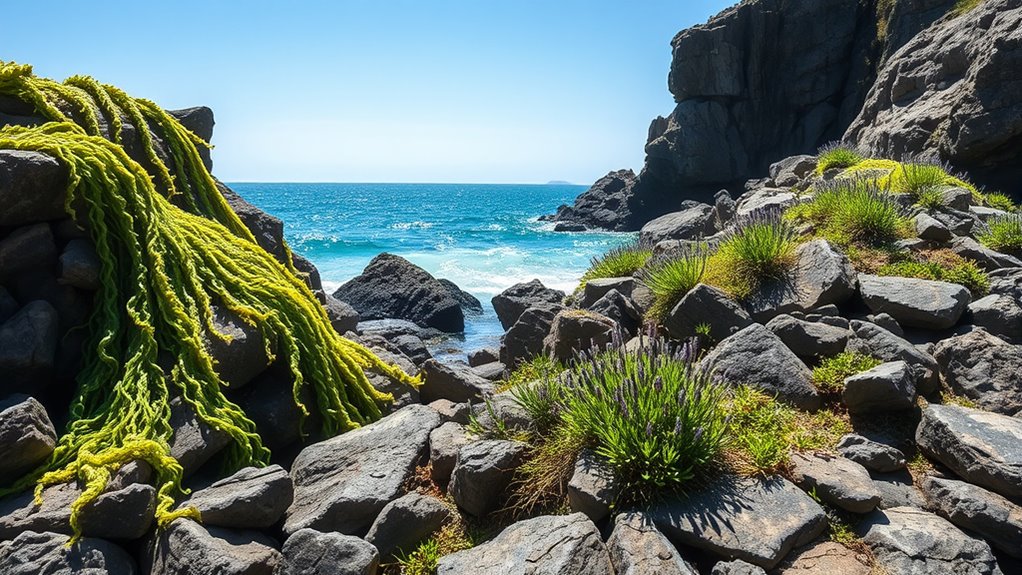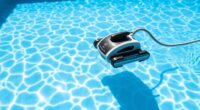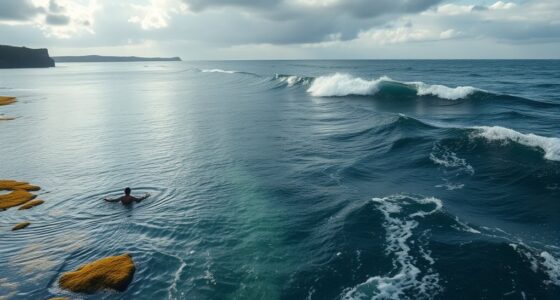When coastal foraging, identify edible seaweeds like nori, wakame, and dulse by their color, texture, and growth patterns, and look for wild herbs such as samphire and sea lavender thriving in salty soils. Follow sustainable practices, use proper tools, and handle plants carefully to avoid damage and guarantee safety. Properly harvesting, storing, and cooking these coastal bounties enhances their flavor and health benefits. Keep learning about safe identification, and you’ll confidently enjoy these natural treats.
Key Takeaways
- Learn to accurately identify edible seaweeds and wild herbs using color, shape, and habitat cues with reliable guides.
- Practice sustainable foraging by harvesting only what is needed and respecting local regulations and ecosystems.
- Use proper tools and safety gear, such as gloves and sharp knives, while handling plants near tides and slippery surfaces.
- Preserve your foraged foods through rinsing, drying, freezing, or pickling to maintain flavor and nutrients.
- Incorporate seaweeds and herbs into meals for their rich nutrients, health benefits, and unique flavors while ensuring correct identification.
Recognizing Common Edible Seaweeds Along the Shoreline
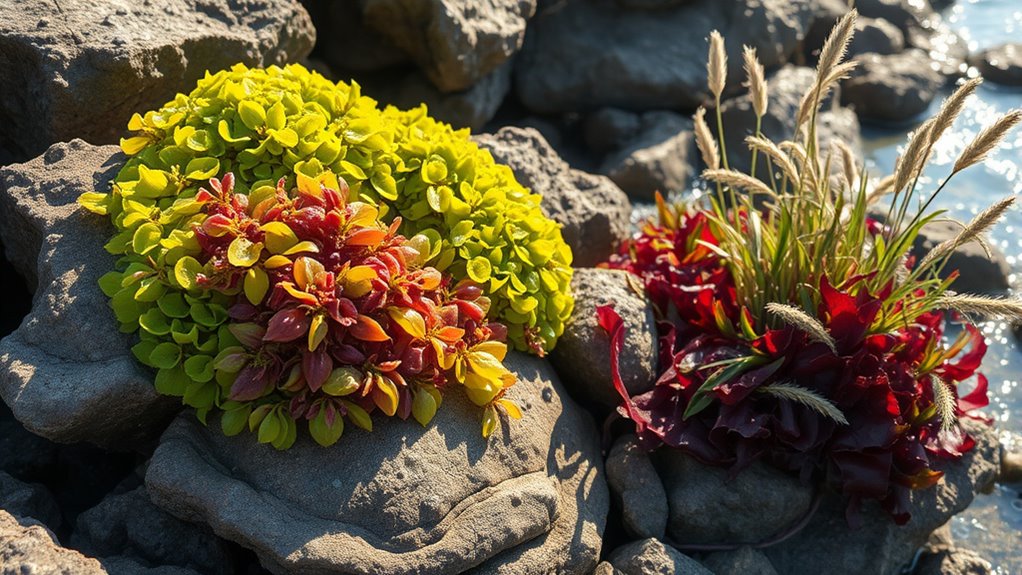
When exploring the shoreline for edible seaweeds, it’s important to learn how to identify the most common varieties. Start with nori, which forms dark green to black sheets with a smooth, papery texture. It often grows on rocks and shells. Sea lettuce is another easy find; it’s bright green, leafy, and resembles lettuce leaves, usually floating or attached to rocks. Wakame has a brownish hue with frilly, ribbon-like blades that curl when wet. Dulse appears as red or purple fronds with a somewhat leathery texture, often attached to rocks or driftwood. Recognizing these varieties by their color, shape, and texture helps ensure you gather safe, edible seaweeds. Proper identification is crucial for safe foraging, especially considering that environmental factors can sometimes affect plant growth or appearance. Understanding seaweed habitats can improve your chances of successful foraging. Being aware of seasonal variations can also help in identifying the best times to harvest different species. Always double-check identification guides before harvesting, as some look similar but are inedible or toxic. Additionally, paying attention to harvesting regulations ensures sustainable foraging practices and helps protect coastal ecosystems.
Wild Herbs Found in Coastal Ecosystems
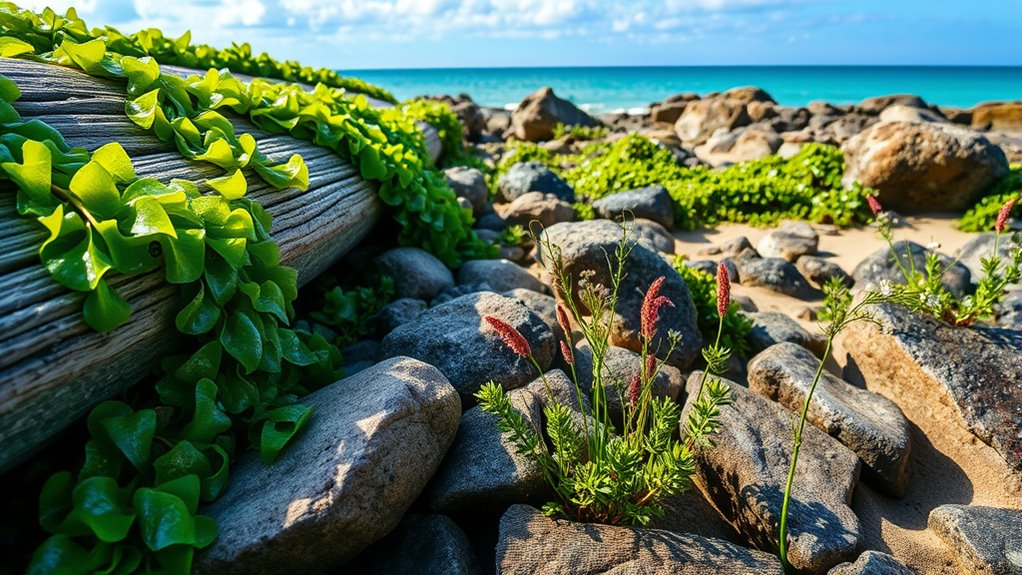
Have you ever noticed the diverse array of wild herbs thriving along coastal ecosystems? These plants add flavor, aroma, and nutrition to your foraging adventures. Coastal herbs like wild thyme, sea lavender, samphire, beach greens, and sea purslane thrive in salty soils and sandy shores. Their vibrant colors and unique scents connect you to nature’s resilience. Imagine gathering fresh herbs that grow naturally, untouched and bursting with flavor. These herbs not only enhance your meals but also deepen your understanding of the coastal landscape. Engaging with these vibrational plants allows you to tune into the natural energy of the environment. Recognizing the unique flavor profiles of these coastal plants can elevate your culinary explorations and appreciation for local biodiversity. Developing attention to these subtle differences can enhance your foraging experiences and foster a greater connection to nature.
Ethical Foraging Practices and Sustainability
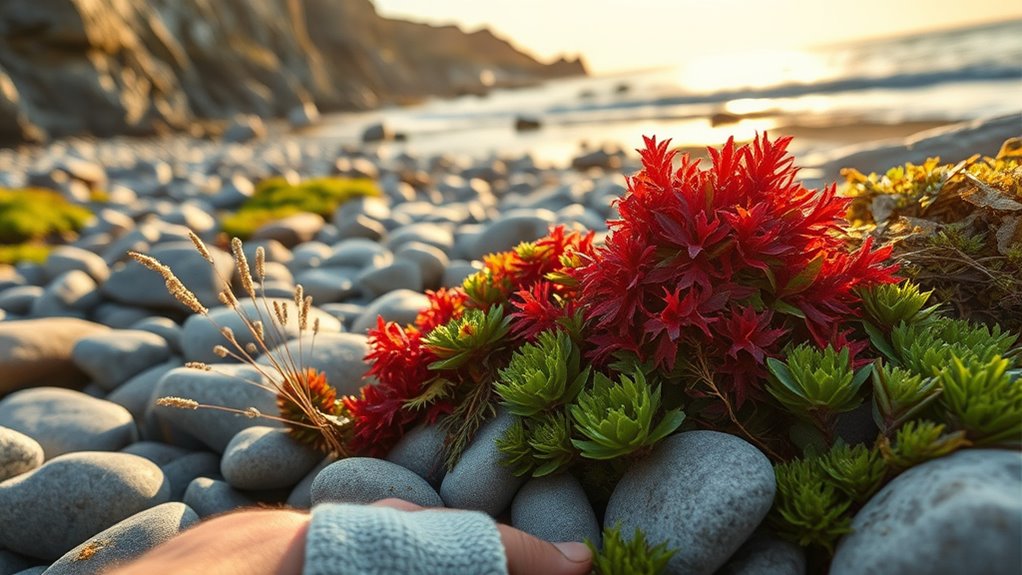
As you explore coastal foraging, practicing ethical methods guarantees these vibrant ecosystems remain healthy and abundant for future generations. Always identify species accurately and harvest only what you need, avoiding overharvesting or damaging the habitat. Respect local regulations and seasonal guidelines to protect vulnerable populations and allow natural replenishment. Avoid disturbing wildlife or fragile plant communities, and never take protected species. Leave no trace by cleaning up all debris and avoid using invasive tools or chemicals. Share knowledge with others to promote responsible foraging within your community. Incorporating sustainable harvesting techniques can further minimize impact and promote ecosystem resilience. By following these practices, you help preserve the delicate balance of coastal ecosystems, ensuring that edible seaweeds and wild herbs continue to thrive for years to come. Your mindful approach supports the health of these essential environments.
Tools and Techniques for Safe Harvesting
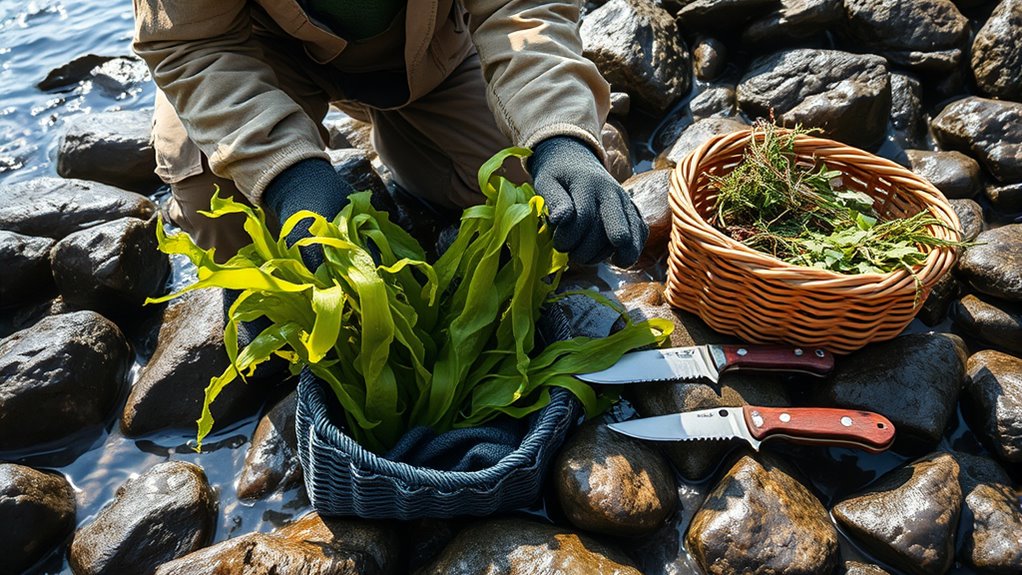
To harvest safely along the coast, you need the right tools, like sturdy gloves, sharp knives, and containers for your catch. Always follow safety practices, such as handling equipment carefully and checking for hazards in your environment. Mastering these techniques helps you enjoy foraging without risking injury or damaging local ecosystems.
Essential Harvesting Gear
Equipping yourself with the right tools is essential for safe and successful coastal foraging. A sturdy, sharp pair of scissors or pruning shears helps you cut seaweeds and herbs cleanly, minimizing damage to plants and the environment. A small, breathable basket or mesh bag is ideal for collecting your harvest, allowing water to drain and preserving freshness. Gloves protect your hands from sharp rocks, shells, or irritants like certain seaweeds. A sturdy knife can be useful for prying loose plants or cleaning your harvest. Additionally, carrying a field guide or app helps identify edible species and avoid toxic look-alikes. Always bring a waterproof container or bag to keep your gear dry and your finds safe during your foraging adventure. Proper tools streamline harvesting and ensure you do it responsibly. Sustainable harvesting practices are also important to ensure the health of coastal ecosystems. Incorporating knowledge of sound vibrations can enhance your understanding of the environment and promote respectful harvesting. Using headphones or other audio devices can help you listen to ambient sounds or guided instructions while working outdoors. Being aware of local regulations ensures your foraging remains legal and environmentally conscious. Additionally, understanding ecological impact helps in choosing sustainable harvesting methods that protect marine biodiversity.
Harvesting Safety Practices
Using the right tools is just the start; applying proper harvesting techniques guarantees your safety and protects the environment. Always handle seaweeds and herbs gently to avoid damaging the plants or harming yourself. Keep your tools sharp and clean to prevent accidents and contamination. Wear gloves and protective clothing to guard against cuts, stings, or irritants. Be mindful of tides and currents, staying clear of slippery rocks or unstable surfaces. Use the following table to remember key safety practices:
| Safety Practice | Why It Matters |
|---|---|
| Wear gloves and protective gear | Prevent cuts and irritations |
| Use sharp, clean tools | Avoid accidents and contamination |
| Be aware of surroundings | Prevent slips, falls, and injuries |
Additionally, always check the local regulations to ensure sustainable and legal harvesting practices. Staying mindful of tides and environmental conditions ensures a safe and sustainable harvest. Proper knowledge of harvesting techniques can greatly reduce environmental impact and minimize risks during your foraging activities. Being familiar with environmental conditions can help you avoid dangerous situations during harvests.
Preparing and Preserving Coastal Edibles

Preparing and preserving coastal edibles guarantees you get the most out of your foraging efforts and enjoy local flavors for longer. After harvesting, rinse seaweeds thoroughly to remove sand and debris, then dry them carefully to prevent spoilage. For seaweeds, air-drying in a well-ventilated space works best; you can also lightly blanch certain types before drying to preserve color and nutrients. Wild herbs benefit from gentle washing and air drying, or freezing if you want to store them longer. Salt preservation is another option; layer herbs or seaweeds with salt to extend shelf life. Proper storage in airtight containers, away from light and moisture, helps maintain flavor and potency. Regular maintenance and proper storage techniques prevent appliance issues, and understanding Gold IRA options can further enhance your ability to store and use your foraged items effectively. Utilizing proper storage methods can also help prevent spoilage and maintain nutrient quality over time. Incorporating mindful relaxation techniques during preparation can make the process more enjoyable and reduce stress.
Delicious Recipes Using Seaweeds and Wild Herbs
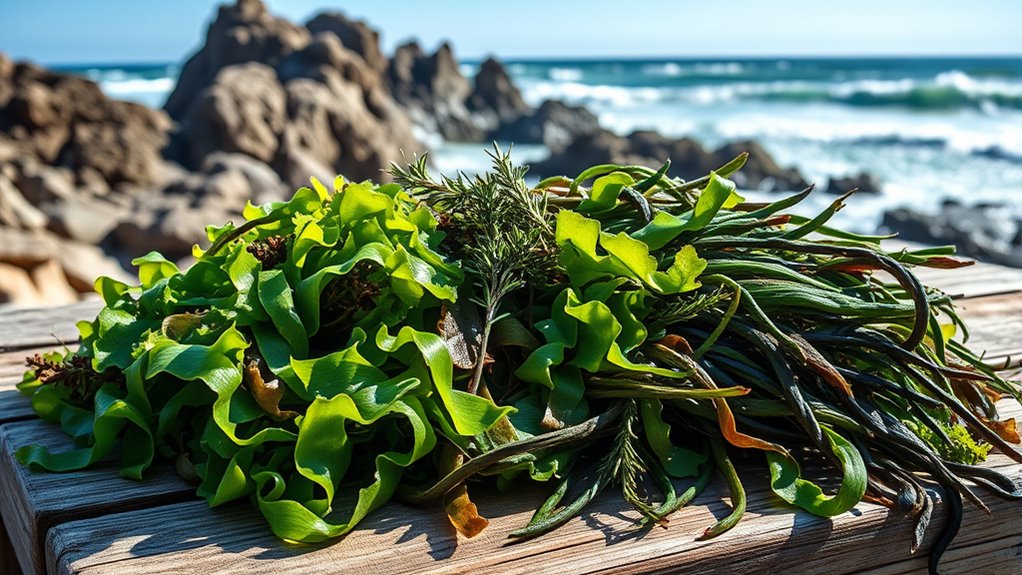
Seaweeds and wild herbs add vibrant flavors and unique textures to a variety of dishes, making them perfect ingredients for creative cooking. You can incorporate seaweeds like nori, kelp, or wakame into soups, salads, and stir-fries to bring umami richness and a briny touch. Wild herbs such as wild mint, oregano, or fennel fronds add fresh, aromatic layers to your meals. Try blending seaweed into pesto or seasoning wild herbs into marinades for grilled fish and vegetables. Dried seaweed flakes make a tasty topping for rice bowls or popcorn. Wild herbs can be used to craft homemade dressings, chutneys, or herbal butters. Experimenting with these ingredients enhances your dishes with natural flavors while celebrating coastal foraging traditions.
Health Benefits of Coastal Foraged Ingredients
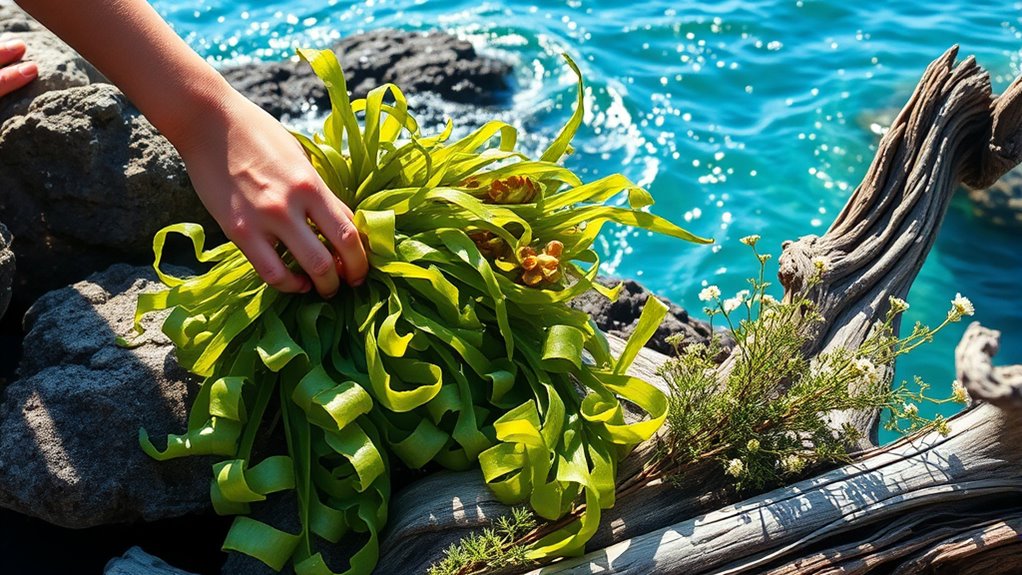
Coastal foraged ingredients are packed with nutrients that can boost your health in many ways. They support your digestion and strengthen your immune system naturally. Incorporating these wild foods into your diet can offer powerful health benefits you might not find elsewhere. Additionally, some edible seaweeds and herbs can be safely harvested and used with proper knowledge of proper handling techniques.
Nutrient-Rich Profiles
Because coastal foraged ingredients grow in nutrient-dense waters, they often pack a powerful punch of vitamins, minerals, and antioxidants. Seaweeds like nori, wakame, and dulse are rich in iodine, calcium, magnesium, and iron, supporting thyroid health, bone strength, and energy production. Wild herbs such as sea fennel and samphire provide vitamin C, potassium, and phytochemicals that bolster cellular health. These ingredients are naturally low in calories but dense in nutrients, making them a smart addition to your diet. Their antioxidant properties help combat oxidative stress, supporting overall wellness. By incorporating these coastal foraged foods, you benefit from a diverse array of essential nutrients that enhance your health and vigor naturally.
Digestive and Immune Boost
Many foraged coastal ingredients actively support your digestive health and strengthen your immune system. Seaweeds like kelp and nori are packed with prebiotics, promoting healthy gut bacteria. Wild herbs such as sea fennel and samphire contain antioxidants that combat inflammation and boost immunity. These ingredients also provide essential vitamins and minerals that help your body recover from stress and illness. Incorporating them into your diet can improve digestion, reduce bloating, and enhance your body’s natural defenses. With their nutrient density and natural compounds, coastal foraged foods offer a simple way to support overall health. Explore adding these ingredients to salads, soups, or snacks to harness their full health benefits. Your body will thank you for the nourishing boost from nature’s coastal pantry.
Tips for Safe Identification and Avoiding Toxic Species
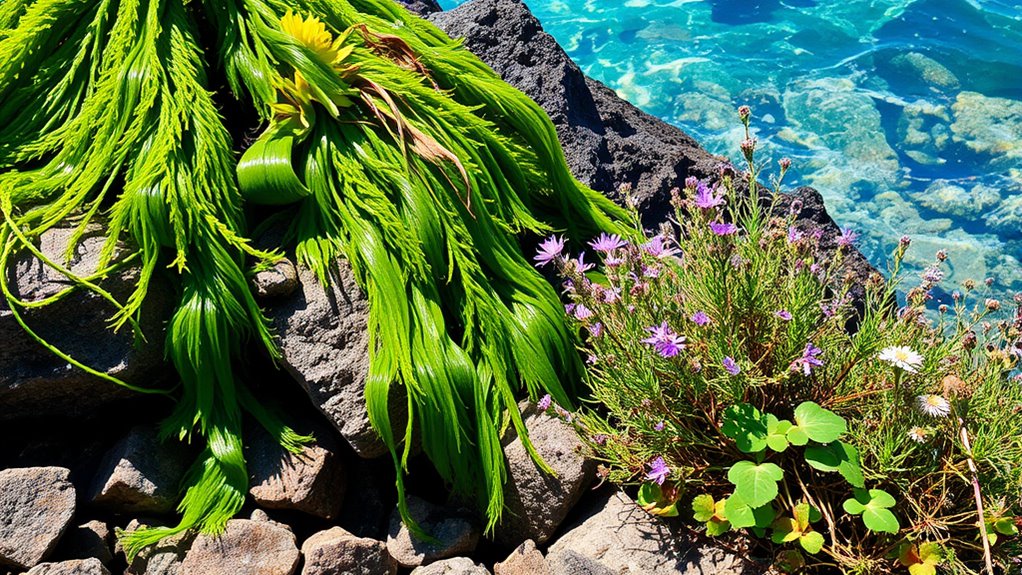
To safely identify edible species while foraging along the coast, it is vital to learn how to distinguish them from toxic counterparts. Start by researching reliable field guides and local identification resources. Pay close attention to key features such as color, shape, texture, and growth patterns. Always check for specific identifiers, like the presence of certain ridges or gills, and avoid species with unusual odors or slimy textures that don’t match known edible varieties. Never consume a plant or seaweed unless you are 100% certain of its identity. When in doubt, consult experienced foragers or local experts. Remember, many toxic species closely resemble edible ones, so taking the time to verify your finds can prevent serious health issues. Safety always comes first.
Frequently Asked Questions
Are There Seasonal Restrictions on Harvesting Specific Seaweeds and Herbs?
You’re wondering if there are seasonal restrictions on harvesting certain seaweeds and herbs. Yes, many regions do have rules to protect wild populations and guarantee sustainability. You should check local regulations, as some species are best harvested in specific seasons to avoid overharvesting and to ensure they’re at ideal nutritional and flavor stages. Always forage responsibly, respecting seasons, and local guidelines to preserve these valuable coastal resources.
How Can I Distinguish Between Toxic and Edible Wild Herbs?
Did you know that misidentifying wild herbs can cause serious health issues? To tell edible from toxic herbs, always learn from reputable sources or experienced foragers. Pay attention to leaf shape, smell, and habitat. Avoid herbs with milky sap or unusual colors. Use a guidebook, and when in doubt, don’t consume it. Proper identification is vital to safe foraging and enjoying nature’s bounty.
What Legal Regulations Govern Coastal Foraging in Different Regions?
You need to check regional laws before foraging. Many areas regulate coastal harvesting to protect ecosystems, restrict collection in protected zones, and ensure sustainability. Local authorities or environmental agencies usually set these rules. Always get permits if required, follow size and quantity limits, and respect designated conservation areas. Staying informed helps you forage legally and ethically, making sure you enjoy coastal resources responsibly without risking fines or environmental harm.
Can Foraged Seaweeds and Herbs Be Used Medicinally?
You might wonder if foraged seaweeds and herbs have medicinal uses, and there’s some truth to it. Many seaweeds contain nutrients and compounds that support health, like iodine and antioxidants. Similarly, wild herbs have traditional medicinal applications. However, always research thoroughly and consult professionals before using foraged plants medicinally, as misidentification or improper use can pose health risks. Nature offers potential, but safety comes first.
How Do Weather Conditions Affect the Safety of Foraged Coastal Foods?
Weather conditions directly impact the safety of foraged coastal foods. Heavy rains can wash pollutants and bacteria into the water, contaminating seaweeds and herbs. Strong winds and storms may cause debris or pollutants to settle on the plants, making them unsafe to eat. Hot, dry weather can also increase toxin levels. Always check local weather reports and harvesting advisories to guarantee you’re collecting safe, clean foods from the coast.
Conclusion
Exploring the shoreline for edible seaweeds and wild herbs is like uncovering hidden treasures along a shimmering beach. With mindful harvesting and proper identification, you can enjoy fresh, nutritious ingredients straight from nature’s bounty. Remember to respect the ecosystem, like a gentle gardener tending delicate plants. Embrace these coastal delights responsibly, and you’ll find that foraging becomes a rewarding adventure—one that nourishes both body and spirit, just like a gust of invigorating ocean air.

